
A more recent article on preventive care for men who have sex with men is available.
This article has been updated to reflect information from the new Centers for Disease Control and Prevention guidelines on this topic.
This is a corrected version of the article that appeared in print.
Am Fam Physician. 2015;91(12):844-852
Patient information: See related handout on preventive health care for men who have sex with men, written by the authors of this article.
Author disclosure: No relevant financial affiliations.
Men who have sex with men (MSM) comprise at least 4% of males in the United States. MSM may describe themselves as gay, bisexual, or heterosexual. Because current medical practice does not always facilitate discussion of sexual behaviors, this group of men may face barriers to receiving culturally competent, comprehensive health care, including preventive services. Barriers include a lack of a welcoming clinical environment, lack of adequate health insurance, and sexual minority stress. Health issues that have a disproportionate impact on MSM include mental health and behavioral problems, smoking and illicit substance use, and sexually transmitted infections (STIs). Family physicians must be prepared to ask explicit questions about sexual activities to determine risk levels for STIs. MSM should receive the same immunizations routinely recommended for other patients, as well as for hepatitis A and B viruses. Although anal Papanicolaou testing is available to screen for cytologic abnormalities, there are no consistent guidelines about its effectiveness. Preexposure prophylaxis is an option for MSM who are at very high risk of human immunodeficiency virus (HIV) infection. For MSM who are not taking preexposure prophylaxis and report a recent high-risk exposure to HIV, postexposure prophylaxis should be offered immediately, preferably within 72 hours of exposure. Because STIs are commonly asymptomatic, screening should be based on risk rather than symptoms. Screening for hepatitis C virus infection is recommended for HIV-positive MSM at least annually and more often for high-risk individuals.
Men who have sex with men (MSM) have been an invisible population in the past in terms of routine health care, although they are estimated to comprise at least 4% of males in the United States.1 Because men may not always disclose male-male sexual activity, the actual number may be higher.
| Clinical recommendation | Evidence rating | References |
|---|---|---|
| Offer vaccinations for hepatitis A and B viruses (if not previously vaccinated) and for human papillomavirus for all MSM through 26 years of age. | C | 12, 15, 22 |
| Offer meningococcal vaccine for MSM with at least one other risk factor (e.g., medical, occupational, lifestyle). | C | 24 |
| Consider preexposure prophylaxis for MSM at very high risk of contracting human immunodeficiency virus because of factors such as multiple or anonymous sex partners. | C | 26, 27 |
| Consider postexposure prophylaxis for MSM who report a recent high-risk exposure to human immunodeficiency virus. | C | 27 |
| Screen MSM for sexually transmitted infections at least annually or more often as necessitated by level of risk. | C | 12, 15–21 |
Recent cultural changes have brought discussions about sexual minorities to the forefront; however, MSM are still less likely to have access to health care and to culturally sensitive clinicians. MSM are also at higher risk of behavioral disorders, smoking and substance use, and sexually transmitted infections (STIs).
The reasons for these health care inequities are multifaceted. Unless the existing barriers are addressed, MSM will continue to face health disparities and a disproportionate burden of disease.
Barriers to Optimal Care
LACK OF A WELCOMING ENVIRONMENT
MSM who seek a supportive family physician may be faced with brochures and websites that lack examples of same-sex couples. At the office front desk, they may be presented with an intake form with the options of “single” or “married” but not “partnered.” Staff members may cause discomfort by asking questions based on the assumption that male patients have female partners only.
LACK OF HEALTH INSURANCE COVERAGE
Married persons typically can obtain health insurance through their spouse's employer. Unmarried MSM cannot obtain such coverage unless the employer provides it for unmarried domestic partners (same-sex marriage currently is not an option in several states).
SEXUAL MINORITY STRESS
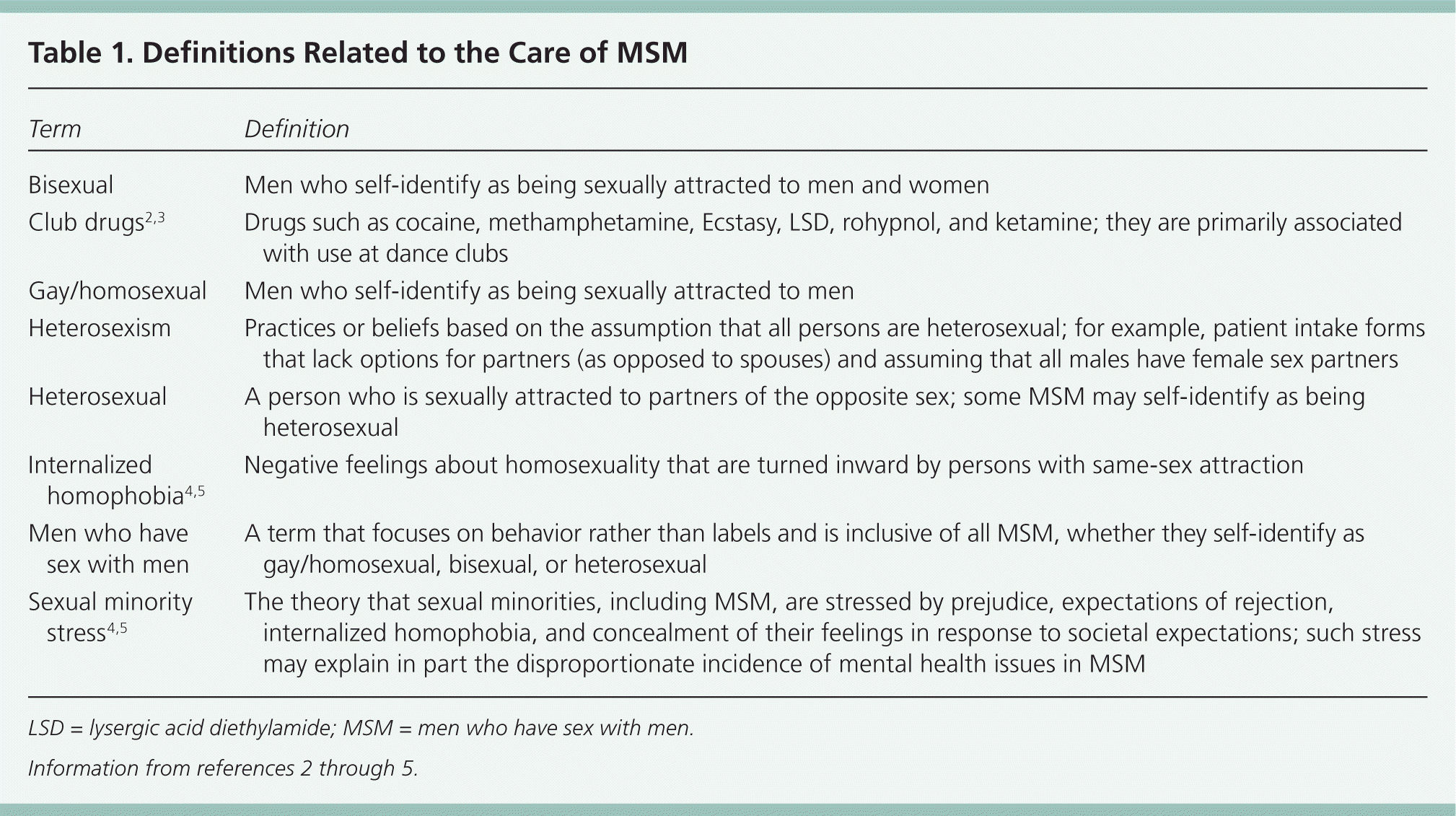
| Term | Definition |
|---|---|
| Bisexual | Men who self-identify as being sexually attracted to men and women |
| Club drugs2,3 | Drugs such as cocaine, methamphetamine, Ecstasy, LSD, rohypnol, and ketamine; they are primarily associated with use at dance clubs |
| Gay/homosexual | Men who self-identify as being sexually attracted to men |
| Heterosexism | Practices or beliefs based on the assumption that all persons are heterosexual; for example, patient intake forms that lack options for partners (as opposed to spouses) and assuming that all males have female sex partners |
| Heterosexual | A person who is sexually attracted to partners of the opposite sex; some MSM may self-identify as being heterosexual |
| Internalized homophobia4,5 | Negative feelings about homosexuality that are turned inward by persons with same-sex attraction |
| Men who have sex with men | A term that focuses on behavior rather than labels and is inclusive of all MSM, whether they self-identify as gay/homosexual, bisexual, or heterosexual |
| Sexual minority stress4,5 | The theory that sexual minorities, including MSM, are stressed by prejudice, expectations of rejection, internalized homophobia, and concealment of their feelings in response to societal expectations; such stress may explain in part the disproportionate incidence of mental health issues in MSM |
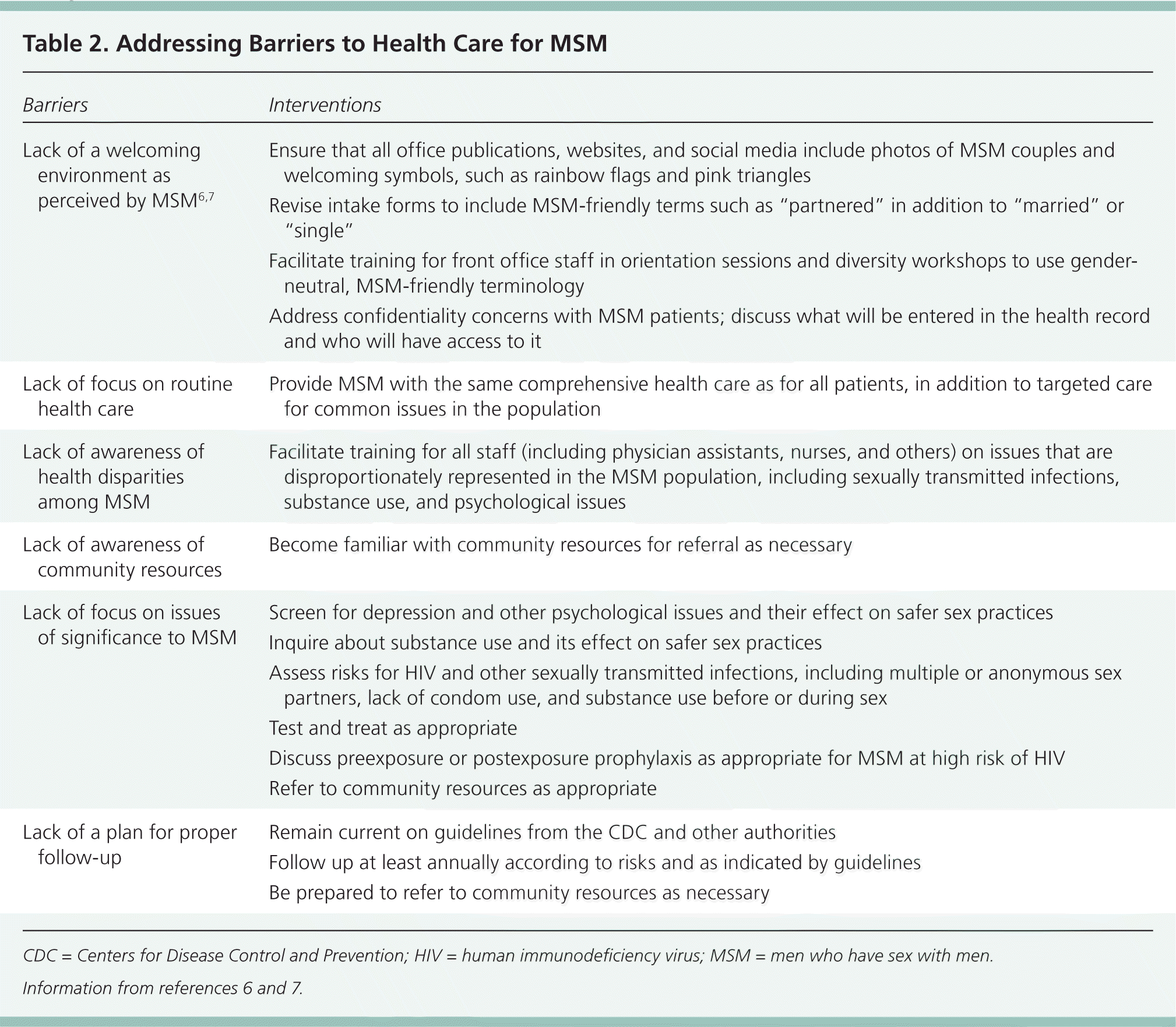
| Barriers | Interventions |
|---|---|
| |
|
|
|
|
|
|
|
|
|
|
Health Issues with Disproportionate Impact Among MSM
Despite the overrepresentation of some health issues in the MSM population, it is important for physicians to focus on MSM as individuals, most of whom will never have mental health issues, use illicit drugs, or contract STIs. Most of what constitutes excellent health care for MSM is the same as for any other patient, regardless of sexual practices.
Because some health issues have disproportionate impact on the MSM population, physicians must be aware of how to address these issues as appropriate to the individual. For example, approximately 40% of MSM develop major depression during their lifetime, which is about twice the prevalence in other men.8 Generalized anxiety disorder, life dissatisfaction, body dissatisfaction, and eating disorders are also common.8–10 MSM are at higher risk of self-directed violence and attempted suicide.9,11 Sexual minority youth in particular are more likely to have depression and more than twice as likely to have considered suicide.2 MSM are nearly twice as likely as other men to be current smokers.9 The use of club drugs (Table 12–5 ) prevalent among sexual minority youth is associated with unprotected sex,2 and methamphetamine use is associated with unprotected anal sex.3
The Centers for Disease Control and Prevention (CDC) states that certain MSM are at higher risk of STIs (viral and bacterial), including human immunodeficiency virus (HIV) infection.12 From the 1980s through the mid-1990s, the rates of unsafe sexual practices and contracted STIs declined in the population, but since then, the rates of early syphilis (primary, secondary, or early latent), gonorrhea, and chlamydia have increased in MSM in almost all industrialized countries.12 MSM, particularly those who are black or Hispanic, are at disproportionate risk for HIV. Risk factors for HIV in MSM include anal sex (receptive or insertive) without a condom, having another STI, having sex with anonymous partners without a condom and using methamphetamines or other drugs to enhance sexual performance.12
eTable A presents the disproportionate impact of STIs on MSM.
| STI | Impact |
|---|---|
| Gonorrhea and chlamydia | Rectal and pharyngeal infections are more likely to be asymptomatic and less likely to be diagnosedA1 |
| MSM with rectal gonorrhea are more likely to be HIV-positive, to use recreational drugs, and to have partners with unknown HIV statusA1 | |
| Hepatitis A and hepatitis B viruses | Approximately 10% of new hepatitis A virus infections and 20% of new hepatitis B virus infections are in MSMA2 |
| Hepatitis C virus | Hepatitis C virus risk factors for MSM include HIV infection and having unprotected receptive anal intercourse with multiple partnersA3 |
| Of the 170 million persons with hepatitis C virus infection, 4 to 5 million are coinfected with HIVA4 | |
| Herpes simplex virus | More common in MSM and may facilitate transmission and acquisition of HIVA5 |
| HIV/AIDS | MSM accounted for 63% of all new diagnoses of HIV infections in the United States in 2010, in addition to 54% of persons living with HIVA6 |
| The HIV diagnosis rate among MSM is 44 times that of other menA6 | |
| HIV rates are disproportionately growing among young men of color, especially black MSM 13 to 24 years of ageA7 , A8 | |
| HPV and anal cancer | Most anal cancers are caused by HPV infectionA9 |
| MSM are about 17 times more likely to develop anal cancer than other menA10 | |
| Anal cancer is more common in men who are HIV-positiveA10 | |
| Proctitis, proctocolitis, and enteritis | Infectious proctitis, which occurs most often in persons who participate in receptive anal intercourse, can be caused by gonorrhea, chlamydia, herpes simplex virus, syphilis, and lymphogranuloma venereumA11 |
| Proctocolitis can be acquired through receptive anal intercourse or through oral-anal contact, whereas enteritis is transmitted only through oral-anal contactA12 | |
| Syphilis | The number of syphilis cases in the MSM population increased 46% between 2008 and 2012 among cases in which the sex of the partner was knownA13 |
| Minority MSM were disproportionately represented in syphilis dataA13 |
Increased sexual risk-taking in MSM may be traced to a variety of factors, including depression and sexual minority stress (Table 32,7 ). High-risk behavior includes multiple and anonymous sexual contacts, substance use during sex, a recent history of STI, and unprotected receptive anal intercourse.
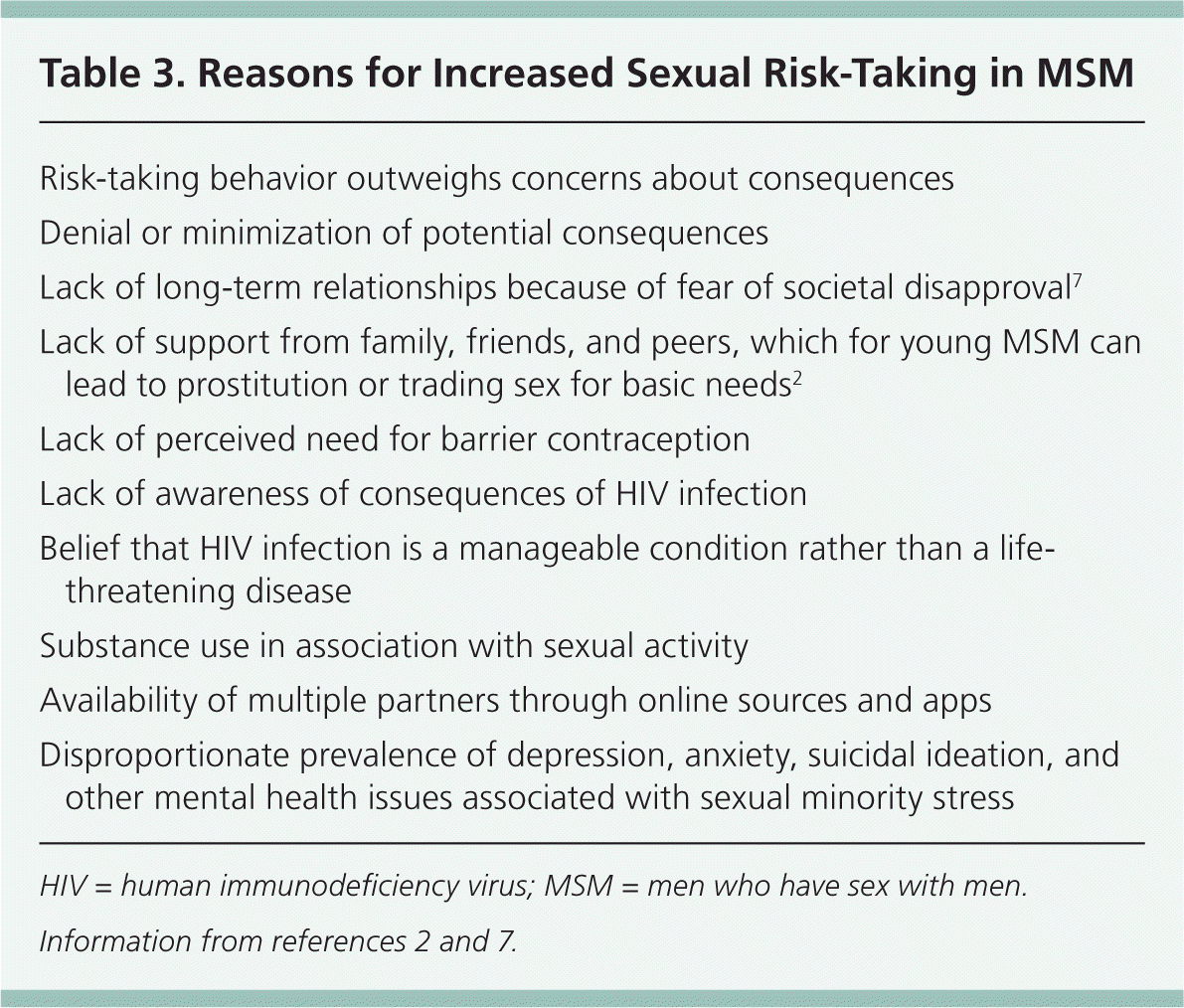
| Risk-taking behavior outweighs concerns about consequences |
| Denial or minimization of potential consequences |
| Lack of long-term relationships because of fear of societal disapproval7 |
| Lack of support from family, friends, and peers, which for young MSM can lead to prostitution or trading sex for basic needs2 |
| Lack of perceived need for barrier contraception |
| Lack of awareness of consequences of HIV infection |
| Belief that HIV infection is a manageable condition rather than a life-threatening disease |
| Substance use in association with sexual activity |
| Availability of multiple partners through online sources and apps |
| Disproportionate prevalence of depression, anxiety, suicidal ideation, and other mental health issues associated with sexual minority stress |
Management of Health Care for MSM
CONDUCTING A CULTURALLY COMPETENT HISTORY
A thorough patient history for MSM includes the same elements as for other male patients, with extra focus on establishing trust through nonjudgmental communication and screening for health issues that are disproportionately represented in the MSM population.
Not all MSM describe themselves as gay or homosexual. Some self-identify as heterosexual, although they have sex with men, and some are bisexual (Table 12–5 ). Asking questions about behavior (e.g., “Do you have sex with men, women, or both?”) instead of labels (e.g., “Are you gay?”) fosters clearer communication between the physician and the patient.
Explicit questions about sexual behavior are necessary to determine risk levels for STIs (Table 4). Some physicians prefer to ask these questions face to face, whereas others provide forms for patients to fill out in advance. The latter approach can save time, but the process may be stymied if the patient is hesitant to hand in forms to front desk staff because of confidentiality concerns. The National LGBT (lesbian, gay, bisexual, or transgender) Health Education Center suggests that each physician choose the process that works best for his or her patients.6
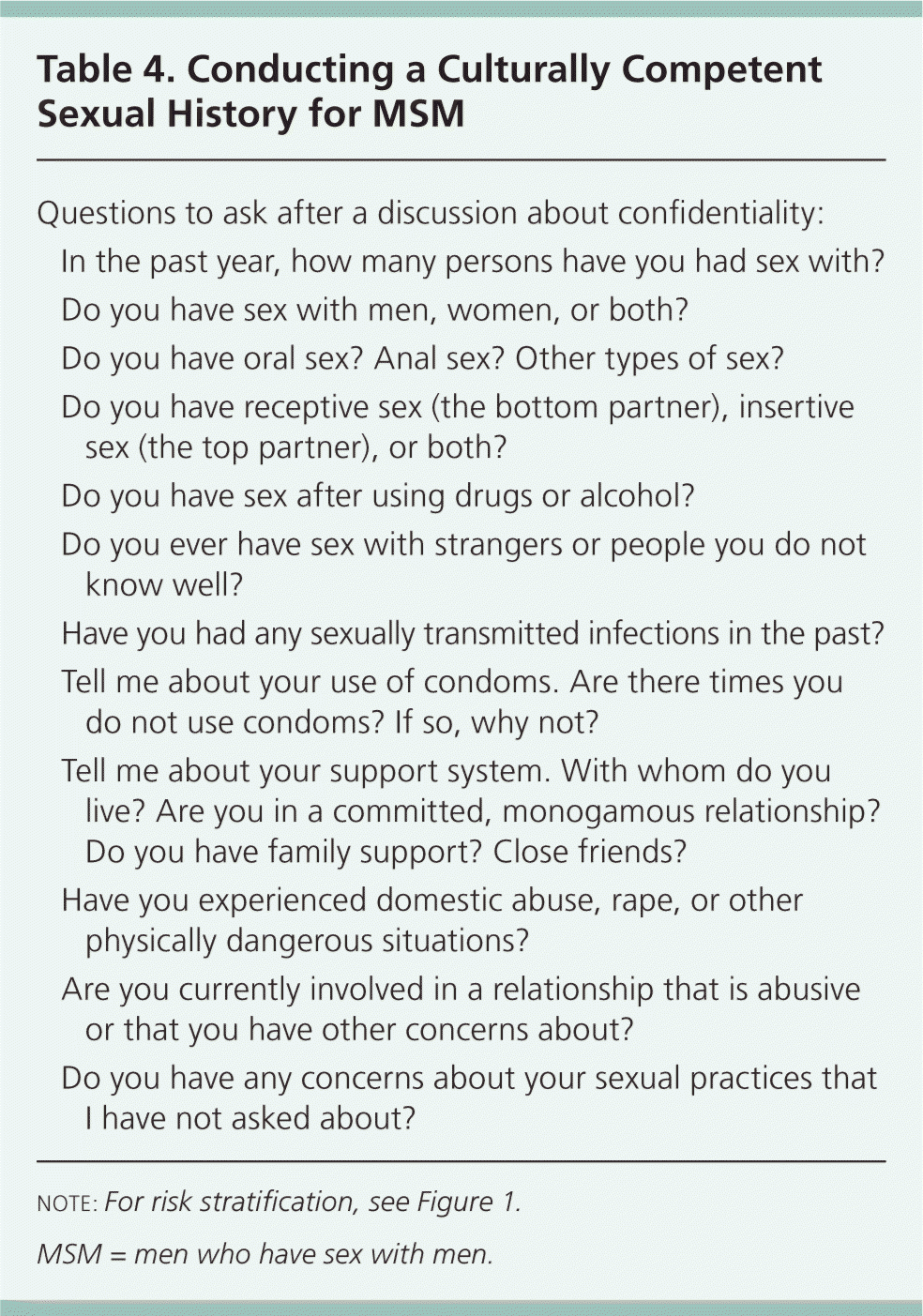
| Questions to ask after a discussion about confidentiality: | |
| In the past year, how many persons have you had sex with? | |
| Do you have sex with men, women, or both? | |
| Do you have oral sex? Anal sex? Other types of sex? | |
| Do you have receptive sex (the bottom partner), insertive sex (the top partner), or both? | |
| Do you have sex after using drugs or alcohol? | |
| Do you ever have sex with strangers or people you do not know well? | |
| Have you had any sexually transmitted infections in the past? | |
| Tell me about your use of condoms. Are there times you do not use condoms? If so, why not? | |
| Tell me about your support system. With whom do you live? Are you in a committed, monogamous relationship? | |
| Do you have family support? Close friends? | |
| Have you experienced domestic abuse, rape, or other physically dangerous situations? | |
| Are you currently involved in a relationship that is abusive or that you have other concerns about? | |
| Do you have any concerns about your sexual practices that I have not asked about? | |
COUNSELING MSM
Family physicians are able to provide the tools and support for MSM to take positive steps to optimize health outcomes.13 This is particularly true for situations in which MSM have been alienated from family structures that traditionally provide emotional and psychological support.8 Risks can be significantly reduced through behavioral interventions, such as counseling, small groups, and workshops.14 Physicians should be ready to refer patients to community-based resources that offer a welcoming, culturally competent environment for MSM.
Because some MSM have experienced discrimination in the health care system, the process of establishing trust may take time. Physicians should begin by explaining the need for several routine questions—including questions about behavioral health, substance use, and sexual activities—and that the questions are being asked only to obtain the information necessary for optimal care. A discussion of confidentiality is helpful, with negotiation about which specific details will be entered into the medical record.
When discussing sexual issues, physicians must be able to define and understand the significance of terms, such as receptive sex (colloquially known as the “bottom” partner) and insertive sex (the “top” partner). Frank discussions about using condoms, choosing less risky behaviors, informing partners of their HIV status, and reducing the number of sex partners should be initiated as appropriate.
Prevention
Prevention for MSM consists of many of the same elements as for other male patients, including dialogue about smoking, substance use, behavioral health, and safer sex practices. In addition, physicians must address the following topics.
IMMUNIZATIONS
MSM should receive the same routine immunizations recommended for other patients. The CDC recommends vaccinations for hepatitis A and B viruses for MSM in whom previous infection or vaccination status cannot be determined.12 The U.S. Preventive Services Task Force (USPSTF) offers no recommendation for hepatitis A virus but recommends vaccination for hepatitis B virus15 (Table 512,15–21 ). The CDC also recommends routine human papillomavirus (HPV) vaccination for all males, including MSM, through 26 years of age.22 Because HPV infection commonly occurs shortly after the first sexual experience, vaccination must be early.23 Meningococcal vaccine is recommended for MSM who have at least one other risk factor (e.g., medical, occupational, lifestyle).24
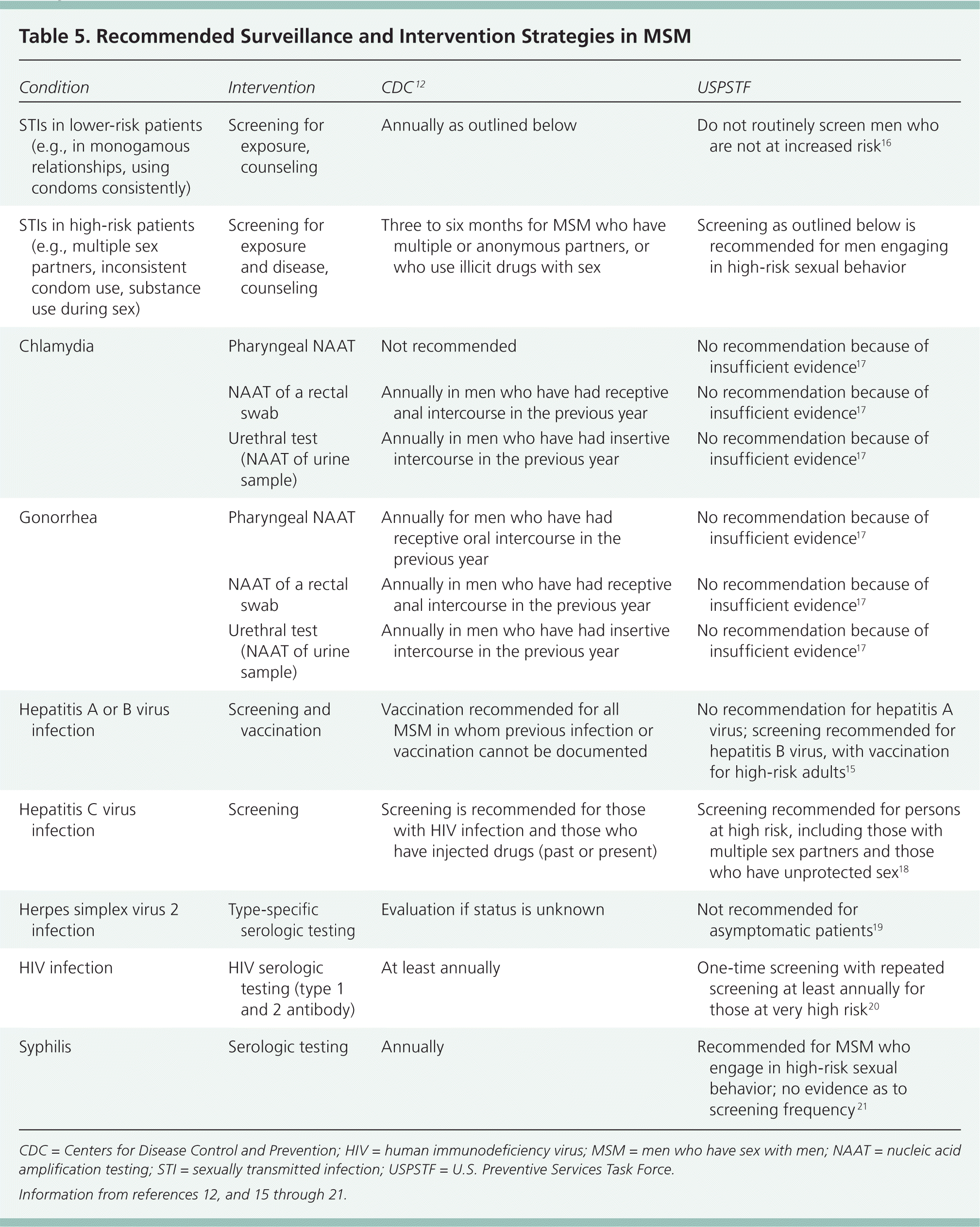
| Condition | Intervention | CDC12 | USPSTF |
|---|---|---|---|
| STIs in lower-risk patients (e.g., in monogamous relationships, using condoms consistently) | Screening for exposure, counseling | At least annually as outlined below | Do not routinely screen men who are not at increased risk16 |
| STIs in high-risk patients (e.g., multiple sex partners, inconsistent condom use, substance use during sex) | Screening for exposure and disease, counseling | Three to six months for MSM who have multiple or anonymous partners, or who use illicit drugs with sex | Screening as outlined below is recommended for men engaging in high-risk sexual behavior |
| Chlamydia | Pharyngeal NAAT | Not recommended | No recommendation because of insufficient evidence17 |
| NAAT of a rectal swab | At least annually in men who have had receptive anal intercourse in the previous year, regardless of condom use | No recommendation because of insufficient evidence17 | |
| Urethral test (NAAT of urine sample) | At least annually in men who have had insertive intercourse in the previous year, regardless of condom use | No recommendation because of insufficient evidence17 | |
| Gonorrhea | Pharyngeal NAAT | At least annually for men who have had receptive oral intercourse in the previous year, regardless of condom use | No recommendation because of insufficient evidence17 |
| NAAT of a rectal swab | At least annually in men who have had receptive anal intercourse in the previous year, regardless of condom use | No recommendation because of insufficient evidence17 | |
| Urethral test (NAAT of urine sample) | At least annually in men who have had insertive intercourse in the previous year, regardless of condom use | No recommendation because of insufficient evidence17 | |
| Hepatitis A or B virus infection | Screening and vaccination | Vaccination recommended for all MSM in whom previous infection or vaccination cannot be documented; all MSM should be tested for HBsAg | No recommendation for hepatitis A virus; screening recommended for hepatitis B virus, with vaccination for high-risk adults15 |
| Hepatitis C virus infection | Screening | Screening is recommended for MSM born between 1945 and 1965, and other MSM if risk factors* are present; HCV testing is recommended for MSM with HIV infection at least annually | Screening recommended for persons at high risk, including those with multiple sex partners and those who have unprotected sex18 |
| Herpes simplex virus 2 infection | Type-specific serologic testing | Test MSM with genital ulcers or other mucocutaneous lesions | Not recommended for asymptomatic patients19 |
| HIV infection | HIV serologic testing (type 1 and 2 antibody) | At least annually for sexually active MSM if HIV status is unknown or negative, and the patient or his sex partner(s) have had more than one sex partner since the most recent HIV test | One-time screening with repeated screening at least annually for those at very high risk20 |
| Syphilis | Serologic testing | At least annually for sexually active MSM | Recommended for MSM who engage in high-risk sexual behavior; no evidence as to screening frequency 21 |
ANAL HEALTH ISSUES
Although anal Papanicolaou (Pap) testing is available, there is no consistent evidence about its effectiveness. The CDC states that evidence is limited about the need to screen for anal cytologic abnormalities, but an annual digital anorectal examination (for HIV-positive MSM and HIV-negative MSM with a history of receptive anal intercourse) might detect masses that could be anal cancer.12 The New York State Department of Health recommends baseline cytology and annual anal cancer screening for MSM who are HIV-positive.25 Directions for performing an anal Pap test are available on the New York State Department of Health AIDS Institute's website at http://www.hivguidelines.org/clinical-guidelines/adults/anal-dysplasia-and-cancer/.
SEXUALLY TRANSMITTED INFECTIONS, PREP, AND PEP
Prevention of STIs in MSM is similar to that of other males in terms of condom use, awareness of a partner's STI status, and avoidance of high-risk behaviors, such as multiple sex partners and substance use during sex. MSM in monogamous relationships or who routinely follow safer sex practices are at lower risk of STIs.
Preexposure prophylaxis (PrEP) is an option for MSM who are at very high risk of HIV and less likely to follow safer sex practices. These include men who use recreational drugs or alcohol during sex, inject drugs, exchange sex for money or services, use condoms inconsistently, or have sex with HIV-infected partners,26 in addition to men who have multiple or anonymous partners.
Before prescribing PrEP, the physician must ensure that patients understand that regular monitoring of medication adherence, HIV status, and adverse effects before and during treatment is necessary. Although PrEP can provide significant protection from HIV infection, it is not a substitute for safer sex practices.27
For MSM who are not taking PrEP and who report a recent high-risk exposure to HIV, postexposure prophylaxis (PEP) should be offered immediately, preferably within 72 hours of exposure. PEP consists of a 28-day course of antiretroviral medications.27
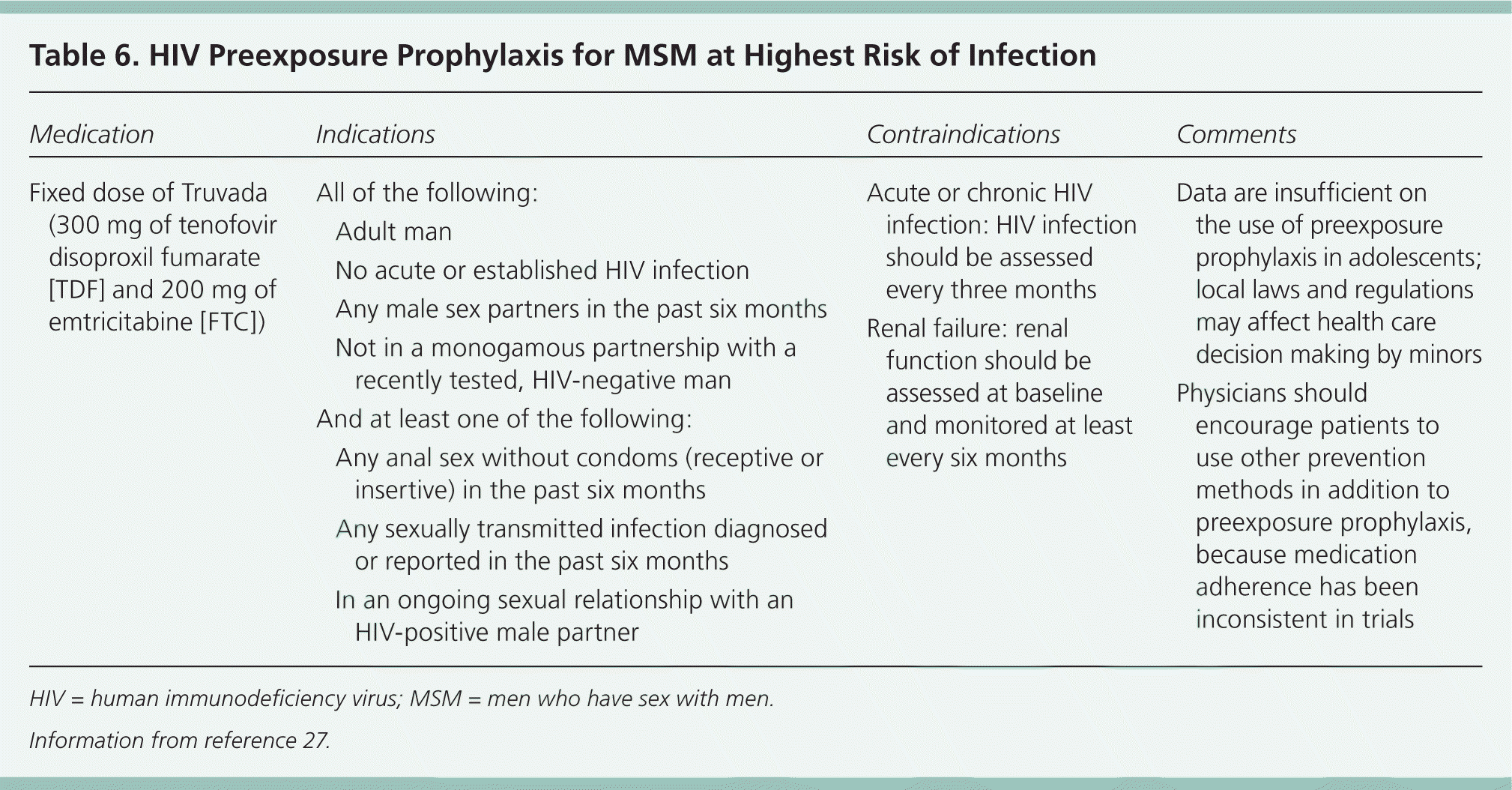
| Medication | Indications | Contraindications | Comments | |
|---|---|---|---|---|
|
|
|
| |

| Medication | Indications | Contraindications | Comments |
|---|---|---|---|
| Highly active antiretroviral therapy taken for 28 days following a high-risk exposure to HIV* | As soon as possible but no later than 72 hours after an isolated HIV exposure | If the exposures are not isolated and the person is not infected with HIV, consider beginning PrEP immediately | Daily PrEP may be more protective than repeated episodes of postexposure prophylaxis |
Screening for STIs
Screening recommendations for STIs in MSM are listed in Table 5,12,15–21 and an algorithm is presented in Figure 1. Because STIs are often asymptomatic, screening should be based on risk rather than symptoms,28 and include pharyngeal, rectal, urethral, and genital examination, as appropriate.29 The CDC recommends that MSM be screened for STIs annually or more often (e.g., every three to six months) if participating in high-risk sexual behavior 12; the USPSTF recommends HIV screening at least annually for those at very high risk.20 The USPSTF also recommends screening for syphilis,21 hepatitis B virus infection,15 and hepatitis C virus infection in high-risk persons.18 Because sexual behaviors can vary over time, physicians must ensure frequent communication to determine the level of risk.8
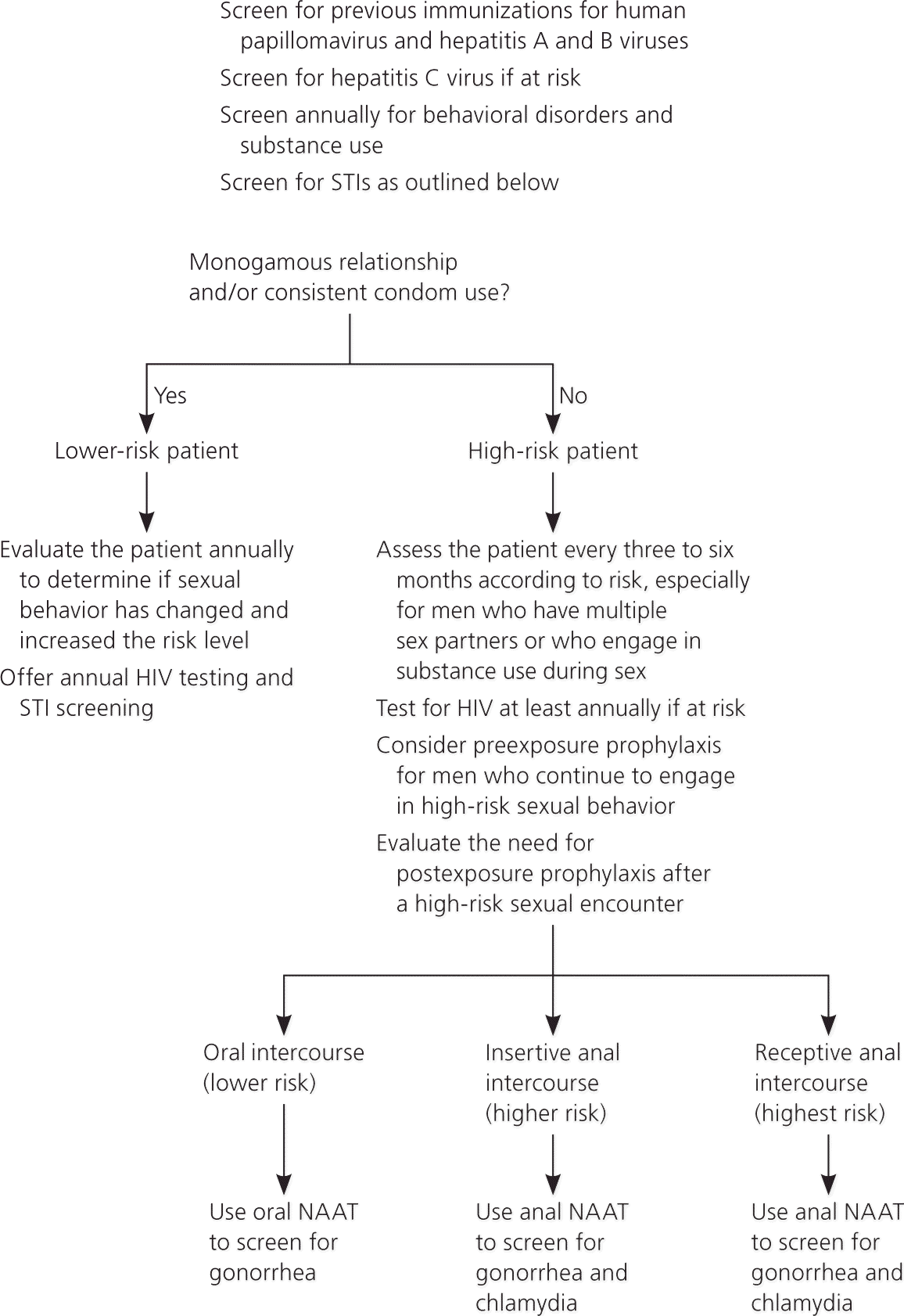
Sexual transmission of hepatitis C virus is possible; therefore, the CDC recommends screening in persons with newly diagnosed HIV infection, especially MSM.12 [corrected]
Data Sources: A PubMed search was completed in Clinical Queries using the key terms MSM, men who have sex with men, gay, homosexual, and LGBT. The search included meta-analyses, randomized controlled trials, clinical trials, and reviews. Also searched were the Agency for Healthcare Research and Quality Clinical Guidelines and Evidence Report, Cochrane Database of Systematic Reviews, Effective Health Care, Institute for Clinical Systems Improvement, National Guideline Clearinghouse, and U.S. Preventive Services Task Force. Search dates: April 2014 to December 2014.
note: This article updates a previous article on this topic by Knight.30
